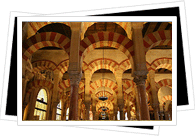Beauty and grace. Culture and architecture.
These are some of the important elements of the Mezquita and perhaps the reasons why it is one of the most sought-after tourist attractions in both Cordoba and Spain. It is a product of history, holding inside its walls influences from different cultures and civilizations; there are traces of Visigothic, Greek-Roman and Egyptian styles. There is also a Byzantine mosaic in the southern part of the Mezquita. In the Cathedral, you may also find Baroque altar vaults and Renaissance domes.
The area where the Mezquita now stands used to hold a Visigothic basilica dedicated to San Vicente. Construction of the Mezquita began in 785 A.D., during Abd al-Rahman I’s reign. The construction lasted for over 200 years, with enlargements and extensions made by succeeding caliphs; the final and most substantial additions were built under the rule of al-Manzur. This consisted of the addition of eight aisles on the eastern part and of the completion of the El Patio de los Naranjos.
When Cordoba fell into the hands of the Spanish crown, under King Ferdinand III, the Christians started to use the Mosque as their church. A cathedral, built in the Renaissance style, was constructed right in the center of the Mezquita. Many arches and columns were destroyed and then substituted with Gothic style replacements, such as in the cathedral. Later on, Renaissance decorations were added, as well as Baroque pulpits and choir stalls. The choir stalls are made in mahogany and were carved by Duque Correjo. There are also two mahogany pulpits that includes a lion, bull and eagle made in marble.
The Mihrab, or prayer hall, was also remodeled in the Renaissance style.
Aside from the Mihrab, there are other Islamic features remaining in the Mezquita, such as the Minaret, which is now a Baroque bell tower; the Orange Courtyard, which has orange trees and fountains; and the entrance gates.